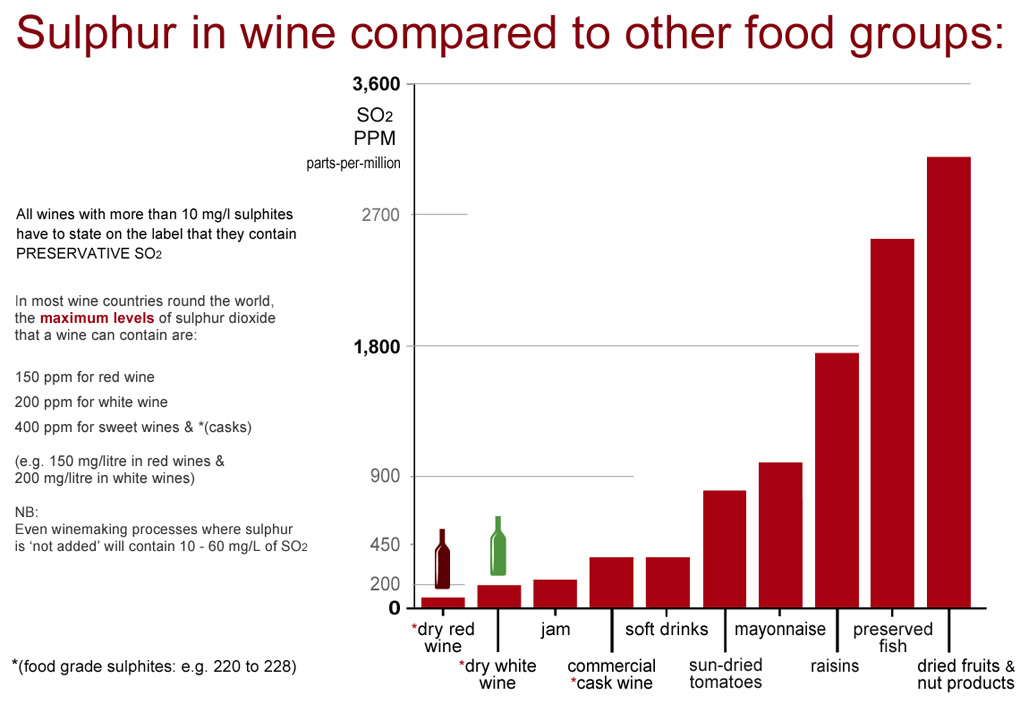Sulphur Levels in Wine:
Wine ‘Contains Sulphites’ - these are words you see on almost every bottle of wine. Just two little words - though frequently misunderstood. The term ‘sulphites’ is an inclusive term for sulphur dioxide (SO2) - a preservative and widely used in winemaking (and most food industries), because of its antioxidant and antibacterial properties. SO2 plays a very important role in preventing oxidization and maintaining freshness in wine.
Consumption of sulphites is generally harmless, unless you suffer from severe asthma or do not have the particular enzymes necessary to break down sulphites in your body. There are people who have a genuine allergy to sulphites, and these are often linked with asthma. Medical authorities’ estimate less than 1% of the population is sulphite-sensitive.
If you do have a sulphite allergy it is more likely to reveal itself through a food product other than wine, as many foods have higher levels of sulphites than wine. The amount of sulphites that a wine can contain is highly regulated around the world. Any wine containing more than 10 parts per million (ppm) of sulphur dioxide must state on the label ‘contains sulphites’.
Medical research is not definitive on the relationship between sulphites and headaches. There are many other compounds in wine such as histamines and tannins that are more likely connected to the headache effect - not to mention alcohol.
In most wine countries round the world - the maximum levels of sulphur dioxide that a wine can contain are 150 ppm for red wine. 200 ppm for white wine, and 400 ppm for sweet wines (150 mg/litre in red wines and 200 mg/litre in white wines). - though the actual levels are much lower. For example, most bottled dry red wines have around 50-75 ppm.
The fact that red wines typically contain less sulphites may seem surprising to people who blame red wine for their headaches. Red wines contain tannin, which is a stabilizing agent, and almost all red wines go through malolactic fermentation. Therefore, less sulphur dioxide is needed to protect the wine during winemaking and maturation.
Another surprising fact is that wine contains about ten times less sulphites than most dried fruits, plus many packaged foods can have levels up to 3000 ppm. So if you regularly eat dried fruit and do not have any adverse reaction you are probably not allergic to sulphites.
It is important to remember that sulphites are a natural by-product of the yeast metabolism during fermentation. So even if you do not add any additional SO2, your wine will still contain sulphites. Today, there are many winemakers who refrain from adding any SO2 until after the fermentation is complete. There are really very few wines that are made without some use of SO2. This is because wine is perishable, prone to oxidation and the development of aldehyde (off-odours). SO2, particularly for white wines, is important for freshness. Wines without any SO2 generally have a shorter shelf life, about 6-9 months, and need to be kept in perfect storage conditions. Given that a winemaker has very little control over the wine’s storage conditions from the time the wine leaves the winery until it is enjoyed, it is little wonder that SO2 is so widely used to help guarantee that the bottle of wine you open will be fresh and clean, and taste as the winemaker intended.
The World Health Organisation recommends a maximum daily intake of 0.7mg of sulphur dioxide per kilogram of body-weight. For a man of average weight this is a bottle of a dry red wine with a concentration of 60 mg/L.
❖ White & Rosé Wines - do not contain natural antioxidants because they are not left in contact with their skins after crushing. For this reason, they are more susceptible to oxidation and tend to receive a larger dose of sulphur dioxide compared to Red wines.
❖ Sweet Wines - get the largest dose, because sugar combines with and binds a high proportion of any added SO2. To get the same level of free sulphur dioxide, the total concentration has to be higher than for dry wines.
Wines with lower acidity need more sulphur than higher acidity wines. At pH 3.6 and above, the sulphites needed is much higher because it’s an exponential ratio. Wines with more colour (i.e. red wines) need less sulphur than clear wines (i.e. white wines). Wines with higher sugar content tend to need more sulphur to prevent secondary fermentation of the remaining sugar.
Wines that are warmer in temperature release free sulphur compounds (the sulphur smell) and can be improved simply through decanting for about 15-20 minutes.
Wineries have been using sulphur around wine for an extremely long time. Back in Roman times, winemakers would burn candles made of sulphur in empty wine containers (called Amphora) to keep the wines from turning to vinegar. Sulphur started to be used in winemaking (instead of just cleaning wine barrels) in the early 1900’s to stop bacteria and other yeasts from growing. It also helps in the extraction of pigments in wine, making red wines brighter. Very sensitive tasters have been noted to smell sulphites in wine at around 50ppm.
❖ Food Group Examples: Levels of Sulphites - (ppm) *Sulphites are naturally occurring minerals:
Tomato sauce 120 ppm, Yoghurt 200 ppm, Canned Soup 230, Bottled Milk (Fresh Whole) 230, *Watermelon 260, *Avocado 300, Fruit Juice 600, Dried Apples 750, Chutneys 750, Salt 1000, Vegetables in Vinegar 1000, Raisins 1800, Peanut Butter 2000, Candied Fruit and *(packaged) Vegetables 3000, Mixed Dried Fruit *(packaged) 3000 ppm.

